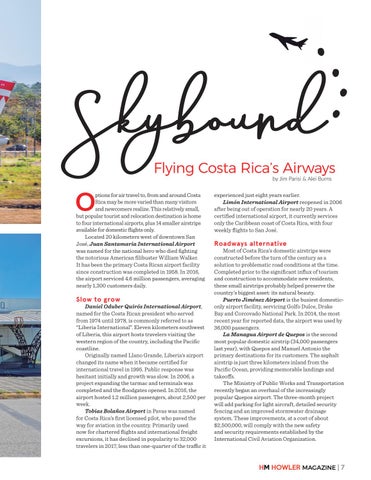..
.. Skybound Flying Costa Rica’s Airways by Jim Parisi & Alei Burns
O
ptions for air travel to, from and around Costa Rica may be more varied than many visitors and newcomers realize. This relatively small, but popular tourist and relocation destination is home to four international airports, plus 14 smaller airstrips available for domestic flights only. Located 20 kilometers west of downtown San José, Juan Santamaria International Airport was named for the national hero who died fighting the notorious American filibuster William Walker. It has been the primary Costa Rican airport facility since construction was completed in 1958. In 2016, the airport serviced 4.6 million passengers, averaging nearly 1,300 customers daily.
Slow to grow
Daniel Oduber Quirós International Airport, named for the Costa Rican president who served from 1974 until 1978, is commonly referred to as “Liberia International”. Eleven kilometers southwest of Liberia, this airport hosts travelers visiting the western region of the country, including the Pacific coastline. Originally named Llano Grande, Liberia’s airport changed its name when it became certified for international travel in 1995. Public response was hesitant initially and growth was slow. In 2006, a project expanding the tarmac and terminals was completed and the floodgates opened. In 2016, the airport hosted 1.2 million passengers, about 2,500 per week. Tobias Bolaños Airport in Pavas was named for Costa Rica’s first licensed pilot, who paved the way for aviation in the country. Primarily used now for chartered flights and international freight excursions, it has declined in popularity to 32,000 travelers in 2017, less than one-quarter of the traffic it
experienced just eight years earlier. Limón International Airport reopened in 2006 after being out of operation for nearly 20 years. A certified international airport, it currently services only the Caribbean coast of Costa Rica, with four weekly flights to San José.
Roadways alternative
Most of Costa Rica’s domestic airstrips were constructed before the turn of the century as a solution to problematic road conditions at the time. Completed prior to the significant influx of tourism and construction to accommodate new residents, these small airstrips probably helped preserve the country’s biggest asset: its natural beauty. Puerto Jiménez Airport is the busiest domesticonly airport facility, servicing Golfo Dulce, Drake Bay and Corcovado National Park. In 2014, the most recent year for reported data, the airport was used by 36,000 passengers. La Managua Airport de Quepos is the second most popular domestic airstrip (34,000 passengers last year), with Quepos and Manuel Antonio the primary destinations for its customers. The asphalt airstrip is just three kilometers inland from the Pacific Ocean, providing memorable landings and takeoffs. The Ministry of Public Works and Transportation recently began an overhaul of the increasingly popular Quepos airport. The three-month project will add parking for light aircraft, detailed security fencing and an improved stormwater drainage system. These improvements, at a cost of about $2,500,000, will comply with the new safety and security requirements established by the International Civil Aviation Organization.
HM HOWLER MAGAZINE | 7
